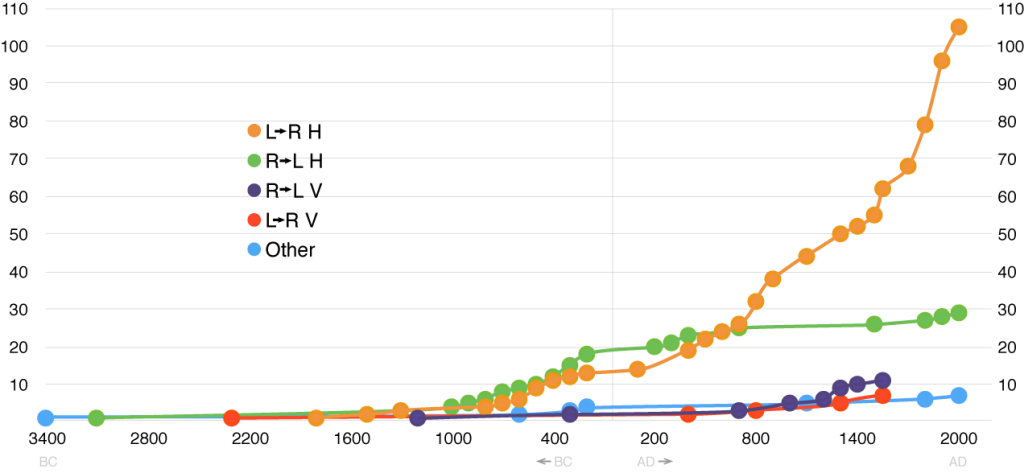Previously we considered the possibility that there is something innate in humans that causes us to prefer left-to-right writing systems. Today we will look at the historic unfolding of writing system directionality. In this light, there doesn’t seem to be a clear, ingrained preference for any particular writing direction. What, then, has driven it?
The timeline below chronicles the history of human writing systems by directionality. The numbers on the y-axis refer to the total number of scripts written in each direction. Each dot represents the emergence of a new writing system (rounded to the nearest 100-year mark). Scripts included on this chart were retrieved from Omniglot’s writing direction index, and the dates of emergence were retrieved from Omniglot, Wikipedia or dedicated niche websites. It should be mentioned that these dates are mere estimates; especially in the BC era, the oldest preserved sample of a script is very likely not representative of the emergence of that script. In any case, we must go off the data we have available, and for this project, rough estimates are sufficient.

Here it is clear that left-to-right writing was not the first to come about. If there were an innate preference for left-to-right, shouldn’t it have emerged first? But alas, first we experimented with boustrophedon and other helter-skelter arrangements of symbols, then right-to-left came about, and then left-to-right-top-down, until finally, around 1800 BC, we came to Linear A and B, which stabilized as left-to-right-horizontal scripts.
From that point through the next several centuries, there was a healthy mix of all sorts of writing system directions around the world. But somewhere along the line this changed, and since 800 AD virtually all new scripts have been left-to-right-horizontal. What happened?
The answer, of course, is Latin. A descendent of Linear A and B, Latin as a distinct script emerged in the 7th century BC. It was then championed by the Roman Empire, became the official script of the Catholic Church, and was used in Gutenberg’s printing press. Thus, a likely explanation for the prevalence of left-to-right scripts in the world is not innate preference, but rather a series of geopolitical reasons, centered on the success of Rome. By the time the Roman Empire fell, the Latin script had been irrevocably established.
In other words, we have happenstance to thank for the left-to-right majority. Okay, there’s a bit more to it… but that’s outside the scope of this blog. If you’re interested in why Europe (and later modern America, a descendent of Europe) rose to world power instead of, say, Aboriginal Australia, I highly recommend the book Guns, Germs and Steel: The Fates of Human Societies, by Jared Diamond.
Besides establishing left-to-right-horizontal as the world’s preeminent script direction, all this has had a few interesting side effects in history. For example:
- As a Roman religion, Christianity promulgated the Latin script. Thus missionaries who traveled to remote (and illiterate) parts of the world to spread the Gospel created writing systems—based on Latin, of course—for the native languages in each zone, which allowed them to later translate the Bible into those languages.
- Because the fifteenth-century printing press used the Latin script and was successful, languages were pressured to use the Latin script as their own writing systems, often with diacritic marks to represent sounds not found in Latin. As a result, alphabets with characters not found in Latin fell on the wayside. For example, þ and ð were letters in Old English, but we don’t use them anymore.